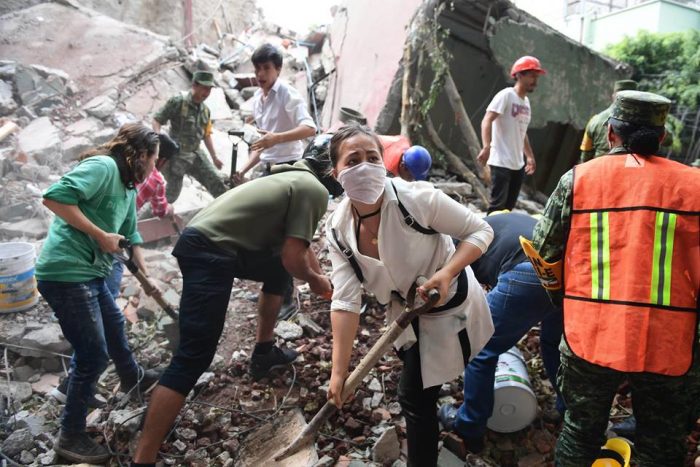
Last updated:
Mexico Earthquakes

Overview
In September 2017, Mexico was rocked by massive back-to-back earthquakes less than two weeks apart.
In September 2017, Mexico was rocked by massive back-to-back earthquakes less than two weeks apart. The first, and largest one struck off the Pacific coast in the Gulf of Tehuantepec, near the state of Chiapas just before midnight local time on September 7. This earthquake measured 8.2 on the Moment Magnitude Scale (Mw), a modification of the Richter Scale in scientific use since the late 1970s, and was classified as a Violent (IX) earthquake on the Mercalli Intensity Scale. A tsunami measuring approximately 5.7 ft (1.75 m) struck in Chiapas, while the city of Salina Cruz to the north and west of the epicentre saw waves measuring 3.3 ft (1 m). The United States Geological Survey (USGS) recorded a further 46 major aftershocks measuring 5.0Mw or more in the weeks following the earthquake.
(Photo: Responders sift through rubble following the Sept. 19, 2017 earthquake that was just south of Mexico City. Source: Ronaldo Schmidt, AFP)
Twelve days later, an earthquake approximately 34 miles (55 km) south of the City of Puebla rocked the states of Puebla and Morelos as well as the Greater Mexico City area. While this quake measured 7.1 Mw and VIII (Severe) on the Moment Magnitude and Mercalli Intensity Scales respectively, it caused significantly more damage because of the location and soil type in the area. Compounding the issue was the fact that a nationwide earthquake drill had taken place as part of the commemoration of the 1985 Mexico City earthquake that had occurred the same day 32 years before. This caused many people to believe that the warning(s) sent out in the seconds before the real earthquake were a continuationof the drill held earlier in the day. A further 39 aftershocks had been recorded as of Sept. 23, 2017. Despite initial concern, research showed that the Puebla earthquake was a separate and distinct event from the Chiapas earthquake and not an aftershock.
Latest Updates
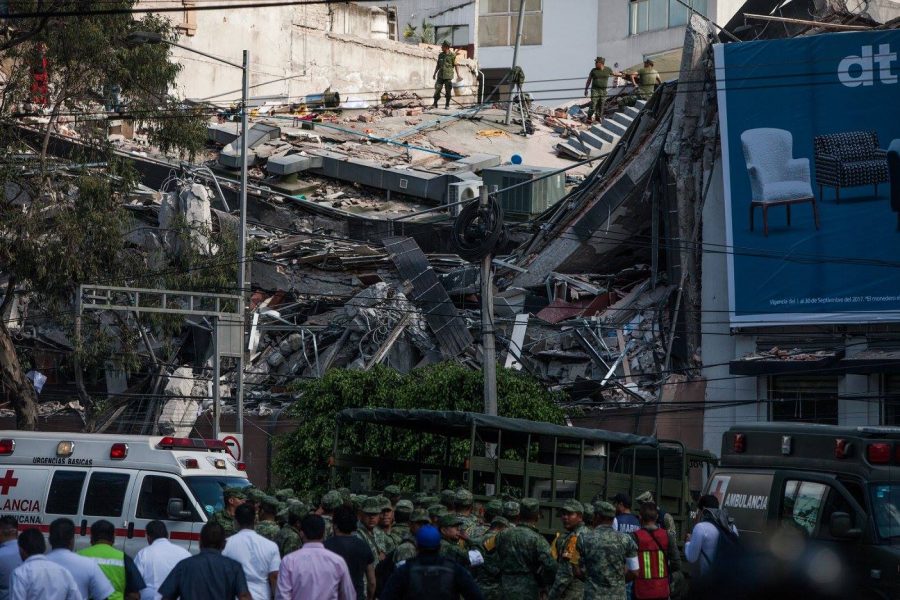
Mexico Earthquake Grants Support Economic Recovery
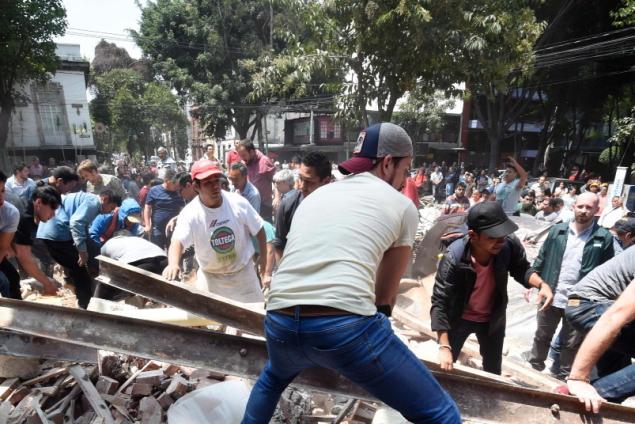
Maria, Mexico City, and Waiting to Give
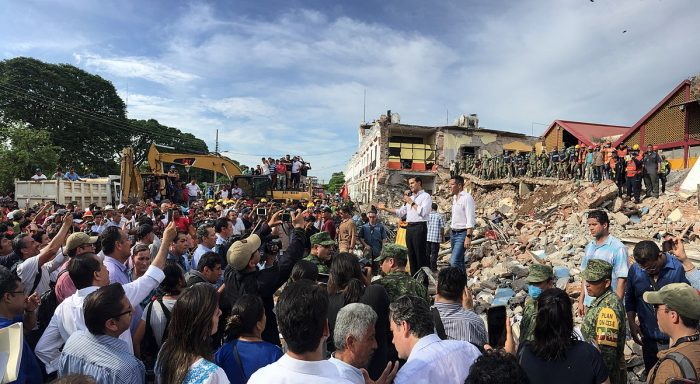
Keeping Mexico in Mind
What was the impact of the first earthquake?
More than two million people were affected by the first earthquake, with thousands of homes destroyed in the state of Chiapas. Other areas outside of Chiapas were also affected, including the states of Oaxaca – where buildings were reportedly reduced to rubble – and Tabasco, Mexico City and the neighbouring country of Guatemala. In Mexico City, a highway bridge under construction collapsed due to the intense shaking while glass at the nearby airport also shattered. Minor to moderate damage was reported as a result of the tsunami, mostly to commercial marinas, with no damage reported to major seaports. A total of 98 people were killed and over 300 were injured as a result of the Chiapas earthquake.
What was the impact of the second earthquake?
The second earthquake, while of a smaller magnitude, caused much more damage because of its location under the heart of Mexico instead of in the waters of the Pacific. At least two churches collapsed, killing 26 people, while 44 buildings in Mexico City also collapsed as a result of this quake. A significant number of the collapsed buildings were built from unreinforced concrete (without steel rebar to provide flexibility) dating from the 1960s and 70s, before building codes changed to require reinforced concrete and masonry. A total of 370 people died and over 6,000 were injured as a result of this second earthquake.
What was the impact on the land?
Mexico City is in a geologically unique location that amplifies the effects of nearby earthquakes. Built on a dry lakebed, the soil underneath Mexico City is made up of ancient sediments that trap and magnify the vibrations from earthquakes. As a result, Mexico City can be affected by extremely distant earthquakes; the 2017 Puebla earthquake’s epicenter was almost 100 miles southeast of Mexico City, while the 1985 Mexico City earthquake’s epicenter was approximately 200 miles from the capital city. When the waves of motion from an earthquake strike bedrock, the rock shakes. When these same waves strike loose sediment such as the type of soil found under Mexico City, it will reverberate back and forth – like ripples in a bowl of water.
“This reverberation doesn’t just carry these waves further—it can actually amplify them. ‘A basin will have natural frequencies, which depend on its shape and size, as well as the material properties of the sediments inside,’ explains Jascha Polet, a geophysicist at California State Polytechnic University, Pomona, via e-mail. ‘When seismic waves make a basin shake at one of these natural frequencies, significant amplification may occur.’” – Smithsonian Magazine
The lakebed soil under Mexico City can also lead to a process called liquefaction where water saturated soil can lose its structure as a result of intense shaking. This soil then begins to behave like quicksand and undermine the foundation of buildings and other structures.
Two years after the earthquake, government aid has been slow to reach those who need it, with many people still living in the rubble of their collapsed homes. Unlimited funds have been promised by the government to 16,907 households, however there is some uncertainty as to what has happened to the previous $800 million reconstruction fund.
Housing
As of the two-year mark, only 38 percent of affected houses had begun the administrative process to receive reconstruction funds from the government.
Structural Reinforcement
Many of the buildings around Mexico were built before contemporary building codes. As a result, they are often brittle and prone to destructive collapse during earthquakes. Reinforcement and retrofits will help increase the structural integrity of these buildings and reduce the potential for injuries or deaths in future earthquakes.
Legal and Administrative Support
Many people are unsure about how to navigate the administrative processes necessary to access governmental funds, or whether they can even begin to remove rubble from their homes. These people would benefit from the support of professionals who can help them navigate the administrative and legal processes necessary to access funds to rebuild their homes.
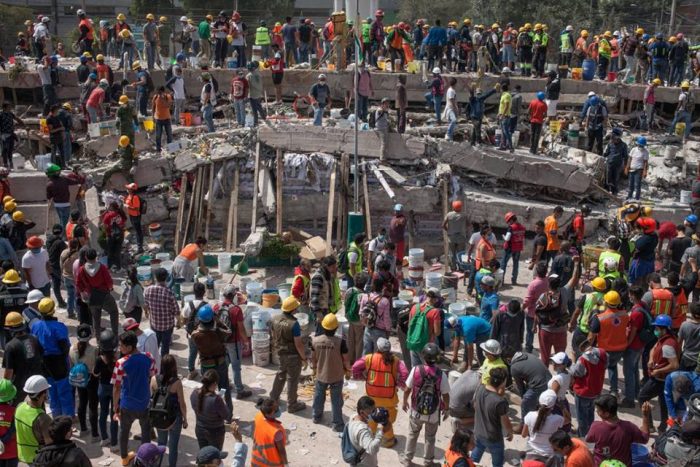
The CDP Mexico Earthquake Recovery Fund supported recovery from this disaster.
Contact CDP
Recovery updates
If you are a responding NGO or a donor, please send updates on how you are working in this crisis to tanya.gulliver-garcia@disasterphilanthropy.org.
(Photo: Volunteers, military, police, and city rescue workers dig through the rubble of a fallen textile factory in the Obrera neighborhood of Mexico City on Sept. 20, 2017. Source: Direct Relief)
Donor recommendations
If you are a donor looking for recommendations on how to help in this crisis, please email regine.webster@disasterphilanthropy.org.
Philanthropic and government support
The Center for Disaster Philanthropy created a Mexico Earthquake Recovery Fund that disbursed $300,000 to support local economic recovery, small business recovery and the creation of a community cultural center. Grants included:
- Mercy Corps received $150,000 to support economic recovery and growth of small businesses affected by the earthquake.
- Fundación Hogares was awarded $74,819 to support local economic and neighborhood recovery in five specific neighborhoods in the Jujutla municipality of Mexico.
- Habitat for Humanity Mexico received $95,183 to support home rebuild projects for 178 families in Puebla who are operating home-based businesses.
- Fondo Acción Solidaria (FASOL) was awarded $19,000 for the creation of a cultural center that allows the community to benefit from meeting space, workshop implementation and cooperatively organized community space.
In addition, CDP and our partners also tracked $34.1 million of philanthropic donations to causes related to the Mexican earthquakes.
- The Liferay Foundation donated $25 to Heart to Heart International for earthquake relief.
- Mama Cash provided a $10,799 grant to Semillas’ “Women Rebuilding their Communities” fund which supports grassroots implementation of long-term recovery strategies.
- C. Johnson & Son, Inc. Corporate Giving and the Sealed Air Corporation Contributions Program both also donated $100,000 to Red Cross Mexico for earthquake relief.
- The K. Kellog Foundation donated $500,000 each to the Fundacion Mexicana De Apoyo Infantil, A.C. and the Fundacion para la Implementacion, Diseno, Evaluacion y Analisis de Politicas Publicas.
We welcome republication of our content. Please credit the Center for Disaster Philanthropy.
Fund resources
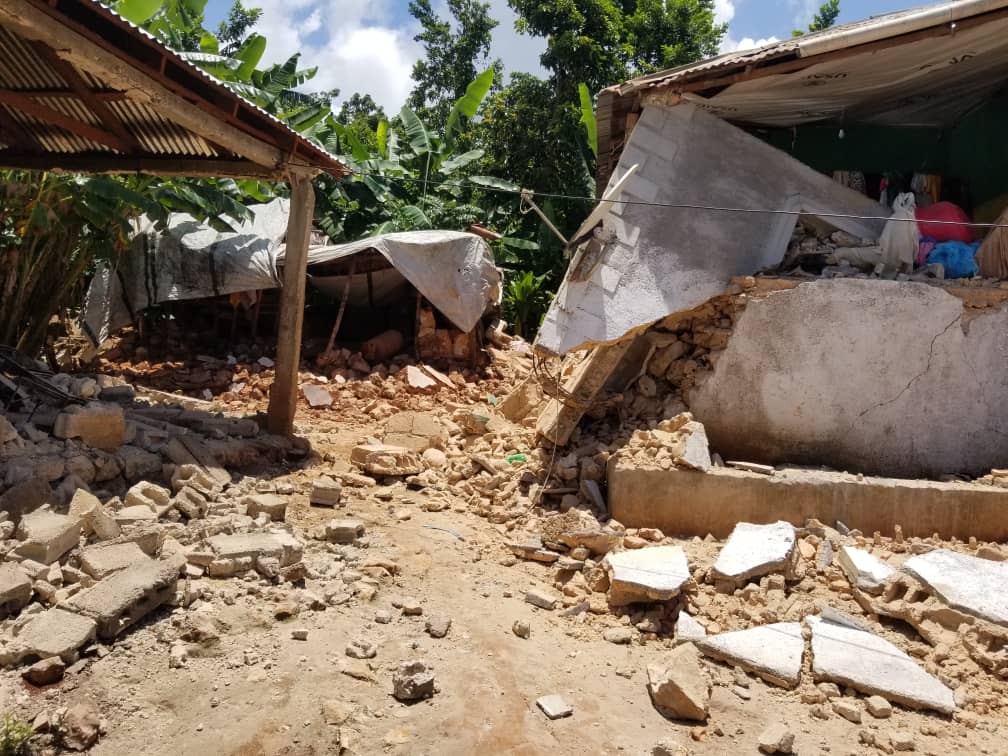
Earthquakes
Striking without warning, earthquakes often are among the most devastating disasters. Caused by the movement of plates along fault lines on the earth’s surface, earthquakes often leave a monumental path of instant death and destruction.
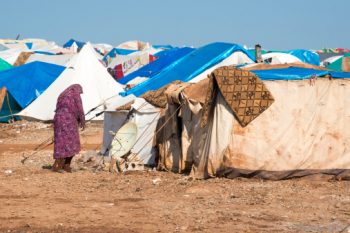
Emergency and Interim Shelter
After a disaster, shelter is more than a place to rest, it is a place of security, access to food, water and medical treatment. A place to start recovering after a disaster.

Resilience
The Latin root of “resilience” means to bounce back, but every field has its own definition and most individuals within each discipline will define it differently. Learn more.